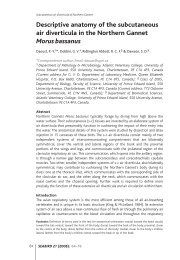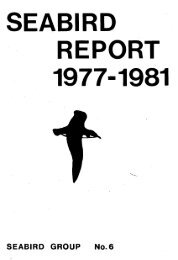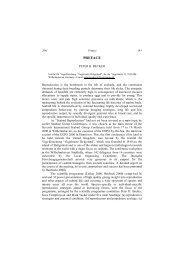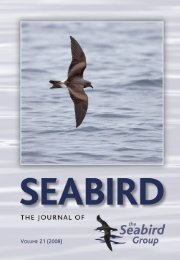Vol 6 No. 2 - The Seabird Group
Vol 6 No. 2 - The Seabird Group
Vol 6 No. 2 - The Seabird Group
Create successful ePaper yourself
Turn your PDF publications into a flip-book with our unique Google optimized e-Paper software.
2004 Diet of Mediterranean Gull 65<br />
POST-BREEDING SEASON DIET OF THE<br />
MEDITERRANEAN GULL LARUS<br />
MELAOCEPHALUS AT THE BULGARIAN BLACK<br />
SEA COAST<br />
BOYAN MILCHEV¹, NIKOLAY KODJABASHEV², YANAKI SIVKOV³ &<br />
DRAGAN CHOBANOV¹<br />
Milchev B., Kodjabashev N., Sivkov Y., Chobanov D. 200 . Post-breeding season<br />
diet of the Mediterranean Gull Larus melanocephalus at the Bulgarian Black Sea<br />
coast. Atlantic <strong>Seabird</strong>s 6(2): 65-78. <strong>The</strong> seeds of three cultivated plants, Barley<br />
Hordeum vulgare, wheat Triticum sp., and Sunflower Helianthus annuus, and of ragwort<br />
Senecio sp., constituted the staple diet of Mediterranean Gulls Larus melanocephalus during<br />
their post-breeding residence at the Atanasovsko Lake Reserve (in 99% of pellets, n = 2,397<br />
pellets). Pellets with fully digested seeds of Barley, Wheat and Ragwort contained a<br />
significantly greater number of gastrolith fragments. <strong>The</strong> pellets containing only visibly<br />
undigested seeds constituted 19% of samples (n = 2,397). Of these, the seeds of seven<br />
species germinated, and five of them had germination rates over 50%. Animal remains were<br />
found in 27% of the pellets (n = 2,397) with terrestrial animals predominating. Of the<br />
invertebrate species, ground beetles in the genus Harpalus (32%, n = 1,226 individuals) and<br />
grasshoppers (24%) occurred in greatest numbers. Vertebrates consisted mainly of marine<br />
and brackish benthic fishes (76%, n = 238 individuals). <strong>The</strong> seeds and stones ingested as<br />
gastroliths came from stubble in crop fields. Gulls flew to beaches to obtain bivalve<br />
seashells as gastroliths and to forage extra food. Gulls feeding mainly in fields after the<br />
nesting season probably reflect the seasonal flush of available food in habitats suitable for<br />
feeding in the region.<br />
¹ SU”St. K. Ohridski”, Faculty of Biology, Dragan Tzankov 8, 1164 Sofia,<br />
Bulgaria e-mail: milchevboyan@biofac.uni-sofia.bg; ² University of Forestry –<br />
Sofia, Wildlife Management Department, 10 Kl. Ochridski Blvd., 1756 Sofia,<br />
Bulgaria, e-mail: ndkodjak@ltu.bg; ³ Museum of Natural History, P.O.Box 173,<br />
9000 Varna, Bulgaria. E-mail: nhmuseum_varna@yahoo.com<br />
INTRODUCTION<br />
Gulls as adaptive, opportunistic omnivores have developed diverse methods of<br />
feeding and have mastered multiple feeding strategies (Burger & Gochfeld<br />
1996, Oro et al.1997). During the nesting period Mediterranean Gull Larus<br />
melanocephalus feeds mainly on land, chiefly consuming terrestrial and aquatic<br />
invertebrates. However, at other seasons, the species frequents shorelines and<br />
feeds mainly on marine fish and molluscs, as well as on garbage and on the








